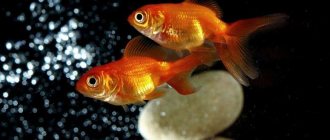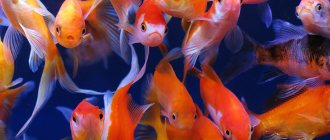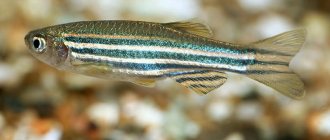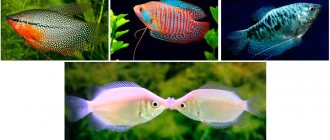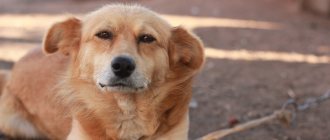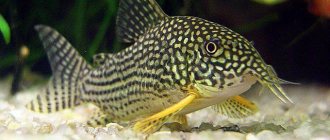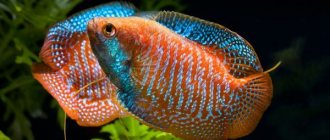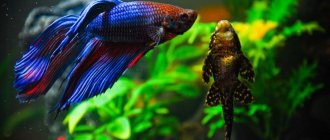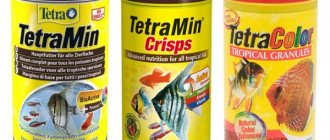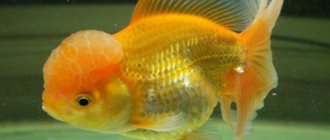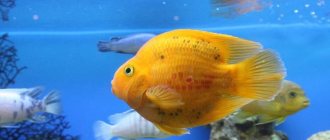Description of the goldfish
Already in the 7th century, this fish began to be used for artificial home keeping; it was then called golden carp.
After centuries of selection, many colors have appeared - white, black, blue, yellow, red - this is not the whole possible range of colors. But all individuals are distinguished by the reddish gold of the large fins and the darker color of the back.
The body of the goldfish has a slightly elongated shape, as if flattened on the sides. In aquarium farming, it is common to divide this species into individuals:
- short-bodied;
- long-bodied.
Photo gallery of Goldfish:
The female can only be identified during the period of gestation by the enlarged abdomen.
In an aquarium, a goldfish grows to a maximum of 15 cm; when living in a larger body of water (pond or lake), the body length can reach 40 cm.
Veiltail
The original form for the veiltail was the ryukin fish , a variety bred by the Japanese. Hence the short, egg-shaped body (up to 20 cm) with a hump located between the dorsal fin and the head. The color of the veiltail comes in red, white and cream tones, and occasionally you can find black. The fins and body come in different colors; speckled colors are also found. The eyes also come in different colors, excluding green, and their size is slightly larger than those of other fish.
Distribution and history of domestication of goldfish
The first mention of a goldfish dates back to the Chinese Jin Dynasty, 264-420 AD.
Presumably, the color of the ancestors of the modern species was truly golden, and the reddish tint appeared as a result of numerous breeding experiments. Fishermen brought Chinese carp home and placed them in cages, barrels, and any containers. A little later they began to engage in its conscious breeding. Over thousands of years of breeding experiments, hybrid mutations have apparently become entrenched and today it is not possible to distinguish them from natural mutations.
In any case, already during the reign of the Tang Dynasty (618-907 AD), a description of a red golden carp appears.
The development of Buddhism led to the growth of general humane sentiments. The monks created merciful ponds where they released all the discarded fish. Thus, the results of unsuccessful experiments, thanks to the tradition of fang sheng (delayed death), also survived and could not help but participate in the consolidation of mutational changes.
With the coming to power of the Song Emperor, home goldfish pools, often with fountains, began to be created en masse in China. Initially, this was the privilege of wealthy citizens, but by the 13th century, golden carp almost everywhere occupied the home ponds of ordinary people.
In the 16th century, this fish came to Japan. The breeders of this country are today considered the best in creating many exquisite species of individuals.
In the 17th century, Dutch and Portuguese merchants brought ornamental carp to Europe, which were initially sold there for fabulous money. There was even a special supply of these aquarium pets from China, Java, and South Africa.
In the 18th century, this aquarium specimen also appeared in the Russian Empire. It was brought along the Great Silk Road as a rare curiosity.
In 1874, a state fish nursery was founded in Washington (USA), in which golden carp became the basis of a rare collection.
The Chinese Cultural Revolution destroyed almost all fish farms in the country, but most importantly, the breeders who kept the secrets of ancient reproduction technologies were shot, which caused irreparable damage to the development of Chinese goldfish breeding.
Recently, the introduction of aquarium inhabitants into the natural environment has become widespread. Thus, in Australia, goldfish have successfully taken root there and many specimens have grown to significant sizes. The weight record for today is 1.9 kg.
Lionhead
It has an egg-shaped body . The main feature of this species is the presence of fairly large convex growths in the gill area, due to which the fish’s head is similar to the head of a lion. The usual body color of the lionhead is red, sometimes with whitish spots. The caudal and anal fins are forked, and there are no fins on the back. The fish can reach up to 20 cm in length.
The choice of an aquarium should be based on approximately 50 liters per individual.
Natural light and small lighting of 0.3–0.4 W/l are allowed. Constant filtration is required, as well as aeration. It is also important to change 1/3 of the fluid every 7 days.
The following water parameters are considered optimal:
- hardness - 7–22°;
- temperature - 16–23 °C;
- acidity - 7–8 pH.
Important! Lionheads are prone to infectious and fungal diseases, so for prevention it is recommended to add
salt to the water at the rate of 5 g per 1 liter of water.
Types of goldfish
The golden one, more than any other aquarium species, has undergone multiple changes, as a result of which hundreds of its varieties have appeared, differing in different body shapes, fins, eyes, scales, and colors.
Chinese breeders alone have produced more than 300 breeds. Among them there are those that can live exclusively in an artificial environment. Others easily adapt to any conditions.
There are also a lot of classifications of goldfish in the world. In China, it is customary to distinguish four main types:
- Se (Grass) are predominantly long-bodied fish without any particular anatomical structure.
- Ven - with growths on the head and fins of rare shape.
- Dragon Eye - distinguished by a special eye shape.
- Egg - characterized by an “egg” body shape and the fact that they do not have a fin on the back.
The division according to the following criteria has become more widespread:
- body structure;
- fin shape;
- eye features;
- type of scales;
- color
By type of body structure
Divides all goldfish into four main groups:
- Wild - the usual form of crucian carp.
- The torpedo is elongated. In China, the typical representative is the Koi carp, in Japan - Wakin.
- The egg is a three-dimensional oval, the body of most modern species is similar.
- A tear or drop is an almost perfect sphere.
By fin type
There are three groups:
- Regular tail. It has one caudal fin, like a common crucian carp, but of different lengths and shapes. In terms of body structure, it is a Wild type or Torpedo. May be of different colors.
- Double tail. They have a fin near the anus and a tail fused from two halves.
- No dorsal fin. These are usually fish with an Egg body shape. They have a smooth back without fins, spines or tubercles.
These groups can be described using examples of breeds.
| Variety | Description |
| Breeds with a regular tail | |
| Ordinary | Similar to crucian carp or crucian carp. It differs only in color. |
| Comet | The tail is elongated, branched, and has the shape of open scissors. The fins are very elongated. Structurally, it is a torpedo, usually white or red. Fast, agile, active fish. |
| Shubunkin | Torpedo with calico multi-colored color. Due to its transparency, the coating is often called flakeless. |
| Bristol Shubunkin | Appeared about 80 years ago in Bristol. The tail is rounded and elongated, resembling a heart in shape. The best specimens are blue, interspersed with multiple other colors. |
| Double Tail Breeds | |
| fantail | Brought out in the 14th-15th centuries. Body structure - Egg or Drop. The tail is clearly divided into two halves, set high and not drooping. The bottom is significantly shorter than the top. The colors are varied. |
| Veiltail | The tail is elongated and pointed without visible division into two parts. The fin on the back is high. Body structure - Egg or Drop. The colors are different. |
| Oranda | There are warty outgrowths at the top of the head, and often on the gills. Japan is characterized by an elongated type, while China has a short body. Various colors. There are many subspecies of Oranda: Calico, Blue, Brown, Chocolate, Little Red Riding Hood, Phoenix and others. This breed is popular in the East. |
| Riukin | The fin on the back is set high, looking like a legionnaire's crest. You can describe this fish as a Fantail with a hump-like growth. He is famous in America and Japan. |
| Pearl | The structure of the body resembles a small ball with a narrow and shallow head. Each scale has a dark edge and a bright middle, protruding relative to the sides, thereby creating the effect of being covered with beads. |
| Tosakin | Since the beginning of the 19th century, it has been one of the most expensive breeds. According to the structure of the body - an egg, the fused long tail forms a circle when viewed from above. |
| Butterfly | When viewed from above, the tail resembles the open wings of a butterfly. Most often they refer to Telescopes. |
| Wakin (Japanese) | A torpedo with a large Fantail tail. Individuals are large. |
| Jikin (Peacock) | Humpbacked Riukin with a large tail in the shape of the letter X. Another striking difference is the red coloring of six parts (lips, fins, tail). Purity of appearance is incredibly difficult to achieve. It is possible to remove white inclusions from the fins. |
| Breeds without a dorsal fin | |
| Fish-Egg | Egg-shaped body structure without a fin on the back and outgrowths on the head. Different tail shapes and colors are acceptable. |
| Lionhead | Known since the beginning of the 17th century as a variety of Fish-Egg. The outgrowths cover the skull almost completely, like a cap that visually enlarges the head. This breed is often called the Bulldog. |
| Ranchu | Has large growths on the skull. Almost indistinguishable from Lionhead. Many color variations. The most common subspecies: Red Riding Hood Ranchu, White Red-Eyed Ranchu, Lyonchu. |
| Pom-Pom | They have large outgrowths of flaps of skin on the nose, resembling pompoms or bouquets. The Chinese Pom-Pom does not have a fin on its back, but the Japanese does. |
By eye type
The easiest way is to look at examples of breed groups.
- Telescope. The eyes are so large that they protrude beyond the skull. There are three types of eyes - domed, flat, round. The structure of the fin is closer to the Fantails, sometimes humpbacked, like Riukins. The color range is varied. One of the modern types is the Moscow Black Telescope. Japanese Telescopes are called Demekins, in America - Moors, in China - Dragon's Eye.
- Stargazer or Heavenly Eye. The eyes protrude strongly above the surface of the skull, but look upward. There is no fin on the back. The smallest breeds.
- Water eyes or Bubble eyes. The eyes protrude strongly, look up, and underneath there are large cavities with lymph fluid. No fin on the back. Some varieties have double bubbles - under the eyes and mouth. Mostly small individuals.
By scale type
Under each scale of the golden carp there are crystals of lime and guanine (silver pigment), according to their concentration, individuals are divided into:
- With matte scales - a low percentage of crystals and little ability to reflect light.
- With shiny - high content of guanine under the scales. The fish has an almost metallic sheen.
- With mother-of-pearl. Under some scales there is no guanine, under others there is a lot of it. It gives the impression of an iridescent cover.
By color
Nowadays there is such a variety of colors that the name “goldfish” is perceived as an anachronism. By type of color it is customary to distinguish:
- Plain. The color has one solid color.
- Spotted (Motley). Spots of a different color are scattered across the main tone. With three shades, the breed is called tricolor.
- Variegated scales. Each scale is painted in several colors.
- Calico type, Calico. Variety of colors and inclusions. Most often blue tones.
- Panda. Usually two colors, black and white. The spots in their location resemble the coloring of the Bamboo Bear.
- Little Red Riding Hood. Two-tone color. The main one is white, the top of the head is red.
Pearl
The pearl has a short body, similar to an egg and reaching 15 cm in length. The peculiarity of this variety is the presence of nacreous convex scales of noticeable sizes, which look like halves of small pearls. The color is usually red, orange and white, sometimes spotted individuals are found, and occasionally black or calico colors are found. If a fish loses pearl scales, then ordinary scales grow in their place and the pearl no longer looks so decorative.
It is recommended to keep this fish in a 30-liter aquarium and add 10 liters of water for each new resident. Aeration is desirable. In general, the conditions are the same as for the regular variety, but the best ones will be:
- temperature - 18–22 °C;
- acidity - 6–8 pH.
You will probably be interested in reading about how to start an aquarium for the first time, where to start a saltwater aquarium, what types of aquarium algae there are and how to deal with them.
Keeping a goldfish in an aquarium
This is not the easiest specimen to keep in an aquarium. Caring for goldfish is quite complicated; you need to remember and follow the basic rules:
- Keep long-bodied and short-bodied species separately.
- Use a rectangular aquarium with a volume of at least 200 liters and a water column pressure of no higher than 50 cm.
- Each fish will require about 2 liters of water. Individuals live in flocks.
- Monitor the temperature. Optimal for long-bodied fish is +17…+25 °C, short-bodied fish +21…+29 °C. This means that it is necessary to equip the aquarium with heated water.
- Equip the aquarium with an aeration device, as goldfish can die if there is a lack of oxygen.
- Consider the issue of compatibility. All goldfish are quite delicate and can get hurt easily. Especially Water Eyes and Telescopes.
- It is not recommended to use stones, shells, driftwood, or other elements with edges that could injure the fish.
- The aquarium should be decorated with plants with hard leaves. This species eats soft things. Veiltails and Water Eyes must live in areas where there is no edible algae.
ORANDA
Fish reach sexual maturity at the age of 1.5 years.
In principle, breeding oranda is not difficult, but the percentage of healthy fry is relatively small.
For spawning, choose an aquarium with a volume of about 50 liters, into which a few bushes of plants with small leaves are placed. The soil must be sandy. In order for the plants to stay at the bottom, their roots need to be pressed with small flat stones.
Compatibility
Goldfish are not aggressive and will easily get along with calm species. The main thing is the coincidence of the temperature conditions of the contents. Various carp, such as Koi, are best suited. But they can eat small fish.
As for catfish, which are often added to keep the aquarium clean, coexistence with slow Tarakatums or Corydoras is possible.
Ancistrus should be avoided as they are nocturnal hunters and can damage a sleeping goldfish.
To preserve the decorative appearance and integrity of goldfish, keeping them with the following aquarium inhabitants is strictly prohibited:
- Angelfish.
- Barbs.
- Cockerels.
- South American and African cichlids.
- Discus.
- Acne.
- Gourami.
- Guppy.
- Mollies.
- Astronotuses.
- Pecilia.
- Rainbows.
- Rasbory.
- Sword bearers.
- Tetras.
- Danio.
- Labeo.
- Shrimps.
TELESCOPE
Keeping these fish is very, very troublesome, because these fish are especially whimsical.
In particular, they are very picky about the oxygen content in water. It is best to take a large aquarium for such fish - from forty liters per pair of fish, and in the aquarium with these fish there should be no stones or decorations with sharp corners
. In general, anything spicy is strictly prohibited because these fish can get hurt very easily. The temperature should vary from twelve to thirty degrees with hardness up to 20, pH from six and a half to eight.
Feeding
It is not difficult to choose a diet for goldfish, since this species is omnivorous.
The following products can be used:
- Multi-component dry ready-made food for fish.
- Any live food, for example, bloodworms, daphnia, earthworms. It is desirable that the protein content is high.
- Aquatic plants and algae - duckweed, vallisneria, riccia, hornwort.
- Herbs such as nettle, green salad, dandelion. It must be given finely chopped.
- Vegetables - pumpkin, carrots, zucchini, cucumber. They should be grated on a fine grater.
Additional, non-daily complementary foods can also include:
- Porridge - buckwheat or millet. Definitely no salt, sugar or oil.
- Sea fish and seafood. They need to be finely chopped.
- Spirulina.
- Bread crumbs.
Comet
Another selection variety that has an elongated body shape , as well as a very beautiful large caudal fin. The length of the fish reaches no more than 18 cm. This species comes in various colors, but individuals whose body color differs from the color of the fins are especially valued. For example, a silver body with red-orange or yellow fins. Colors may vary depending on conditions of detention. To preserve color, you need to choose good food and provide sufficient lighting, but with shaded areas.
The comet likes to dig into the soil, so when arranging the bottom you should choose coarse sand or pebbles. Delicate algae can damage fish, and it is advisable to choose plants that are rigid in structure with large leaves - Nomaphyla straighta, Aponogeton viviparidae. Experts also recommend covering the top of the aquarium with special glass, since comets like to jump on the surface of the water and can fall out of the aquarium.
We recommend that you read about how to breed and keep plants such as Marsilia, Sagittaria, Pogostemon, Hornwort, Java moss, Cryptocoryne and Hemianthus micranthemoides in an aquarium.
They love space, so you need to choose an aquarium based on 45–50 liters per 1 fish. Good aeration as well as filtration is recommended. Fluid change - 25–30% at least once every 7 days.
The following water parameters are considered optimal:
- hardness - 6–18°;
- temperature - 18–23 °C;
- acidity - 7 pH.
Comets are unpretentious when it comes to food, but their diet should include both live food and plant origin.
They can fast for a whole week. Did you know? Goldfish can reach quite large sizes. Thus, in 2010, in France, the media reported that fisherman Raphael Biagini caught a unique specimen of a goldfish weighing approximately 15 kg.
Breeding
Goldfish become sexually mature at 12 months. But to obtain full-fledged offspring, it is preferable to use individuals starting from 2 years old.
To mate, several males and a female are placed in a small container with plants. Favorable conditions for breeding offspring are shallow water, so the water level is not raised above 25 cm. During the day, full light is provided - natural or artificial.
The bottom must be hard. A special mesh is placed on it, which will save the eggs from being eaten.
The appearance of individuals ready for mating changes. Small tubercles resembling mother-of-pearl appear on the gills of males, and peculiar saw-tooth notches appear on the pectoral fins. The males try to push the female deeper into the algae.
Spawning occurs in spring, usually April-May, and lasts almost six hours. Then the adults are returned to the community aquarium. One female is capable of laying up to 10 thousand eggs.
Selection
In nature, crucian carp spawning begins in April or May. Aquarium goldens breed several times a year, starting at 1–2 years of age. If necessary, the process is stimulated by replacing more than a third of the water or raising the temperature.
Readiness for reproduction is determined by the increase in the abdomen in females. Fertilization occurs through characteristic contact between the fish's anal openings.
04:49
GOLDFISH BREEDING
To start a 40-liter spawning tank, they purchase a lamp and an aerator, and plant the container with dense vegetation so that the parents do not feast on the laid eggs. The larvae, which form on the third day, hang upside down between the algae leaves. After 3–5 days (depending on the water temperature), the fry appear, rush upward and swallow air to be able to swim in a horizontal position.
Aquarists who have been breeding goldfish for more than one year often become breeders, either accidentally or intentionally. Having received offspring, they keep specimens with pronounced characteristics of the breed and discard the fry that do not meet the standards.
If you replenish the aquarium with fish with characteristics you like over the course of several years, you can consolidate the species characteristics and even improve the breed.
Goldens are literally pets!
Golden ones attract owners not only with their appearance, but also with their behavior. Pets become attached to their owners, take food from their hands, and swim onto a palm placed in the water, which is especially popular with children.
Riukin
Riukin is another popular type of goldfish for aquariums. It was brought to Japan around the 16th century from the Ryukiu archipelago. This fact determined the name of the fish.
These specimens have a short body, but considerable size - they can reach a length of up to 20 cm. A distinctive feature is the sharp elevation of the back in the form of a hump, starting immediately behind the head. There is a straight fin on the back. The color scheme of this fish is varied and ranges from red-silver to black tones. But in most cases it is the red riukin that can be found. Calico colored fish look amazing, but the red and white color of these specimens looks very aesthetically pleasing in ponds. This species has a fairly large forked tail.
Due to their large size, riukins are very popular when decorating decorative ponds and pools. They can also be kept in an aquarium based on the proportion: 2 fish per 100 liters. It is important to change 1/3 of the total fluid at least once every 7 days. Aeration and filtration must be installed. You can feed with bloodworms, worms, daphnia, porridge, and plant-based feeding is also needed. Regular feeding of ornamental fish is also advisable.
To set up an aquarium, it is recommended to take soil of fine or medium fractions. Since riukin feeds on algae, it is better to choose quickly growing plants (for example, elodea, hornwort). The lighting of the home should be bright enough.
The following parameters are considered optimal:
- hardness - about 20°;
- temperature - 18–22 °C;
- acidity - about 7 pH.
Very expensive mutants
In the breeding of silver crucian carp, two branches can be distinguished: short-bodied and long-bodied forms. The first ones look more impressive. Several hundred variations have now been developed. Among the well-known ones: comet, oranda, red cap, telescope, veiltail, lionhead, they are found quite often. But there are also very expensive individuals. The Shubunkin with a blue body tone and black and orange spots scattered throughout it is very valuable. A variety of ranchu called “Batik” looks unusual. All the nuances of color can be better seen in the photo of this goldfish. The tiger captivates with its color and transparent, speckled fins. Manufacturers in Thailand have some of the most expensive ones: orandas, riukins, pearls, panda telescope.
Tendency to diseases
With proper care, fish rarely get sick. Signs that your pet is sick or experiencing discomfort:
- refusal to eat;
- protruding scales;
- drooping dorsal fin;
- various rashes on the body (ulcers, dark spots, plaque);
- swollen abdomen;
- unnaturally bulging eyes;
- strange behavior (the fish stands motionless, with its head buried in the ground or wall of the aquarium, lies on the bottom, leaning on its side, or swims near the surface, quickly swallowing air);
- When moving, it turns over onto its back.
If your pet has one or more suspicious signs of deterioration in its condition, immediate measures must be taken to treat it.
